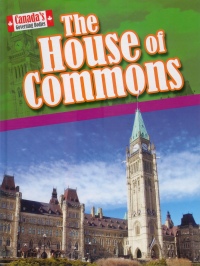| ________________
CM . . .
. Volume XXI Number 27. . . .March 20, 2015
excerpt:
This excellent volume in the “Canada’s Governing Bodies” series provides students and teachers with a succinct, readable explanation of Canada’s federal government system’s history and operation. Students will learn that Canada’s federal government is a representative parliamentary democracy, largely based on the British model. There are two legislative houses in the federal system: the House of Commons (the lower house) and the Senate (the upper house). There is also the mostly symbolic monarch, represented by the Governor General, and the judiciary composed of the Supreme Court of Canada and the lower federal courts. This volume focuses on the role of the House of Commons. The House of Commons and the Senate make the laws that are applicable to all Canadians: national defense, banking, foreign affairs and citizenship. The Members of Parliament (MPs) are elected to represent the people who live in Canada’s 308 ridings. The number of MPs has changed over time as has the makeup of the House. The first woman elected to the House of Commons was in 1921, and the first Aboriginal was not elected until 1968. There are currently 308 MPs representing ridings of the provinces and territories, and most MPs are members of Canada’s various political parties. The number of MPs will increase after the 2015 election. The party with the most seats forms the government, and its leader becomes Prime Minister; the party with the second most seats is known as the Official Opposition. The text offers students a clear explanation of how a bill is put forward to make a new law or to change existing legislation. Legislative bills are introduced and debated in the House of Commons and, if passed, are sent to the Senate to be debated and passed. The six steps are: the bill becomes part of the official record at first reading; it is debated during the second reading; it goes to a committee of MPs for examination; the House debates the report and may offer amendments or changes to the bill in the report stage; the amended bill is debated again during third reading and voted upon; if passed, it goes to the Senate for approval; if both chambers agree on a final version of the bill, it is granted Royal Assent by the Governor General. Readers learn that there are many important positions and functions in the House of Commons. The MPs elect a Speaker of the House who makes certain that parliamentary rules are followed and who only votes in case of a tie in a parliamentary vote. The Prime Minister is the leader of the party that has the most seats in the house, and s/he is the senior government official and decides what bills are introduced. Cabinet Ministers are appointed by the Prime Minister to be the heads of government departments, and they meet in cabinet to discuss budgets, policies and bills. The leader of the official opposition leads the debate during votes and suggests different policies. Students learn the history of the House of Commons, and some of its most important members are introduced: Prime Ministers Sir John A. McDonald, William Lyon Mackenzie King and Pierre Trudeau; the New Democrat Tommy Douglas and Agnes McPhail, who was the first woman to sit as an MP. There is a “Know the House of Commons” quiz, and questions for students to debate are offered. Recommended. Ian Stewart teaches at Cecil Rhodes School in Winnipeg, MB.
To comment
on this title or this review, send mail to cm@umanitoba.ca.
Copyright © the Manitoba Library Association. Reproduction for personal
use is permitted only if this copyright notice is maintained. Any
other reproduction is prohibited without permission.
Next Review |
Table of Contents for This Issue
- March 20, 2015. |
